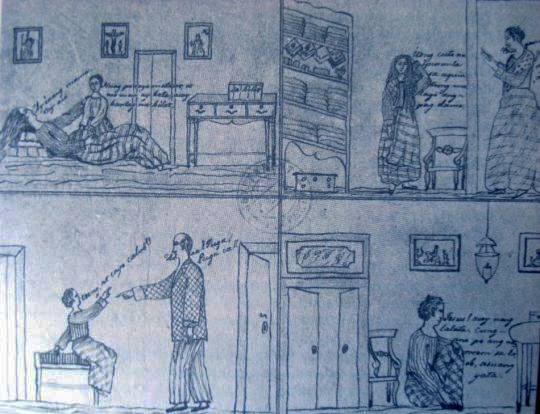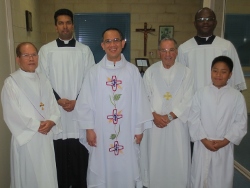From Renato Perdon collection of historical writings

ONE OF THE national traits that helped Filipinos survive national crises is the Filipino sense of humour.
‘Even in the midst of corruption and injustices, even in the face of hunger and degradation,’ my mentor, the late historian Teodoro A. Agoncillo once commented. ‘The (Filipino) masses could laugh not only on the foibles of the Spanish civil and ecclesiastical rulers, but also at themselves.’
Our national hero, Dr. Jose Rizal, himself exemplified the Filipino with a sense of humor. Together with his comrades in the Propaganda Movement, Rizal’s ‘numerous stories on the mundane activities of the Spanish friars, which rival those of Giovanni Boccacio’s The Decameron, testify to the Filipinos’ sense of humour.’
Behind the serious, calm and dignified personality of Rizal, lies the man with a witty, playful ways and sometimes mischievous character.
Remembering his childhood, for example, Rizal would write about an aunt who could not read the holy bible in Tagalog unless she was lying flat on her back or about her spinster cousin having the hobby of confessing daily to the parish priest even the most trivial infractions of table manners.
From the ‘Epistolario Rizalino’, a five-volume compilation of Rizal’s numerous letters to his family, relatives, and friends, the late Prof. Esteban A. de Ocampo, former chair of the National Historical Commission from whom I learned many things abour Rizal when I worked as his assistant researcher for many years prior to migrating to Australia 1988, cited some of the hero’s witticism rarely found in other great men.
Writing his sister Josefa in Manila to buy a pair of slippers for their mother, Dońa Teodora Alonso, Rizal made his mother’s specifications as: not the ‘one with heels nor one without soles’… a pair with soles consisting of two layers.’
In one of is earliest letters to Ferdinand Blumentritt, dated 28 November 1886, Rizal said: ‘I was already expecting to receive your photograph with your last letter. Mine will follow or will ask the photographer to take my ethnographic picture, or I will sketch myself before a mirror, but it will be faithful and I will not flatter myself.’
Answering the letter of another propagandist, Marcelo H. del Pilar, who probably requested a copy of Rizal’s picture, the great Malayan quipped: ‘I have my picture taken and within a week you will have a deluge of my photographs.’
‘The stamp on the envelope of your letter has not been cancelled. I am returning it; you can use it better than I. It is a pity to throw it back.’ This was his reply to a letter of his friend Ferdinand blumentritt, when Rizal was staying in Berlin, said Prof. de Ocampo.
Rizal’s literary style in writing satires can evoke a combination of a rapier-like sting and boisterous laughter. Following is a portion of Rizal’s article, Tears and Laughter, published in the 30 November 1889 issue of La Solidaridad, a parody-prayer to an imaginary God of Freemen:
‘Thou always help the strongest, in order not to quarrel with him, and Thou give the reason to the one who has the strongest clutches. Thou created the lion, tiger, fox and Sagasta who levies taxes on eight million people and denies them the representation in the Cortes [Spanish legislature]… Though who promised to look after those who thirst for justice, keep our welfare, Sagasta, and all the conservative, those who deny us the Penal Code, the friars of the four corporations and those who with time may go there [Philippines], the civil guards, the carabineers, and government employees! Don’t also forget to send us every fortnightly the worst left-overs in Spain…’
Humour is said to be a good medicine. And this is just what Rizal used in parrying the criticism howled by the friars against his novel, the Noli. Writing back against Fr. Salvador Font, his foremost critic, Rizal said, ‘… What a father and a criticism! If the author of a novel had to be responsible for the sayings of his characters, holy god, what end would we come! Because, following this system, the opinions of Fr. Damaso would be mine…’
Still on the subject, Rizal wrote Mariano Ponce: ‘With regard to the booklets of Fathers Rodriguez and Font, I have the great pleasure to see that even writing with the feet I can do them terrible harm; what now if I should get to write with the hand…! For the rest, I believe these friars have written their booklets with the hand, with the tongue, and with the head, but as they cannot give more, they remain there.’
In another letter to Blumentritt, Rizal talked in a flash of wit about his sojourn in Tokyo, Japan: ‘Here you have your friend Rizal, the wonder of the Japanese who has the face of a Japanese but does not speak Japanese. On the streets, when I go shopping, people look at me and badly educated children laugh because I speak English… some believe that I am a Europeanised Japanese who does not want to be taken as such.’
‘As a Filipino who had travelled extensively and rubbed elbows with many nationalities,’ Prof. de Ocampo added, ‘Rizal possessed a keen sense of humour that can be characterized as witty rather than scandalous.’
While in Germany, the hero was invited to a meeting of the Geographic Society by his friend Mr. Feodor Jagor and introduced to the renown ethnographer Virchow. In a light vein, the scientist told Rizal that he would be very happy to study the Filipino ethnography. In an equally light mood, Rizal countered that, for love of science, he is graciously presenting himself as the first specimen. And should exigencies arise, Rizal volunteered, he can produce a second specimen in the person of his countryman, Maximo Viola.
Sales talk bordering on flattery sometimes induces laughter. This was precisely the case when Rizal solicited the help of his long-time chum atnd former classmate at the Ateneo, Fernando Canon, in the distribution of the Noli. Rizal wrote him: ‘You have a commission of 10% of the sale of the book. You have a right to give complimentary copies that you wish. And as a proof of my appreciation, I decorate you and give you my caricature, begging you to accept it as a remembrance of your friend and classmate whose greatest glory consists of being admired by one like you.’
Rizal’s two immortal books, the Noli me Tangere and the El Filibusterismo, are rich sources of Rizal’s wit and humour. Though Rizal’s humour in these books may not evoke spontaneous laughter, his wit, nevertheless, can appreciate ludicrous ingruity of the then prevailing situations and events.







Leave a Reply